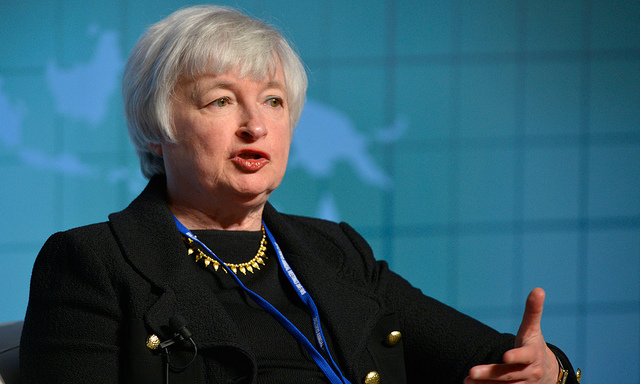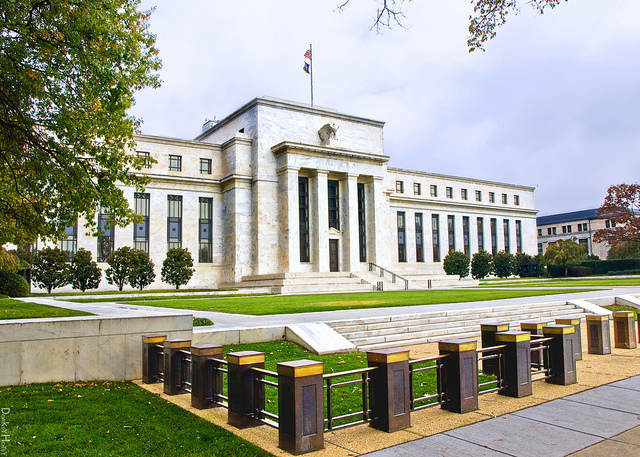Redacted Version of the March 2015 FOMC Statement

| January 2015 | March 2015 | Comments |
| Information received since the Federal Open Market Committee met in December suggests that economic activity has been expanding at a solid pace. | Information received since the Federal Open Market Committee met in January suggests that economic growth has moderated somewhat. | Shades GDP down. |
| Labor market conditions have improved further, with strong job gains and a lower unemployment rate.? On balance, a range of labor market indicators suggests that underutilization of labor resources continues to diminish. | Labor market conditions have improved further, with strong job gains and a lower unemployment rate. A range of labor market indicators suggests that underutilization of labor resources continues to diminish. | No change. |
| Household spending is rising moderately; recent declines in energy prices have boosted household purchasing power.? Business fixed investment is advancing, while the recovery in the housing sector remains slow. | Household spending is rising moderately; declines in energy prices have boosted household purchasing power. Business fixed investment is advancing, while the recovery in the housing sector remains slow and export growth has weakened. | Shades down their view of exports.
|
| Inflation has declined further below the Committee?s longer-run objective, largely reflecting declines in energy prices.? Market-based measures of inflation compensation have declined substantially in recent months; survey-based measures of longer-term inflation expectations have remained stable. | Inflation has declined further below the Committee’s longer-run objective, largely reflecting declines in energy prices. Market-based measures of inflation compensation remain low; survey-based measures of longer-term inflation expectations have remained stable. | Notes flattening of implied future inflation rates.? TIPS are showing lower inflation expectations since the last meeting. 5y forward 5y inflation implied from TIPS is near 1.94%, down 0.09% from January. |
| Consistent with its statutory mandate, the Committee seeks to foster maximum employment and price stability. | Consistent with its statutory mandate, the Committee seeks to foster maximum employment and price stability. | No change. Any time they mention the ?statutory mandate,? it is to excuse bad policy. |
| The Committee expects that, with appropriate policy accommodation, economic activity will expand at a moderate pace, with labor market indicators continuing to move toward levels the Committee judges consistent with its dual mandate. | The Committee expects that, with appropriate policy accommodation, economic activity will expand at a moderate pace, with labor market indicators continuing to move toward levels the Committee judges consistent with its dual mandate. | No change. They are no longer certain that inflation will rise to the levels that they want. |
| The Committee continues to see the risks to the outlook for economic activity and the labor market as nearly balanced.? Inflation is anticipated to decline further in the near term, but the Committee expects inflation to rise gradually toward 2 percent over the medium term as the labor market improves further and the transitory effects of lower energy prices and other factors dissipate.? The Committee continues to monitor inflation developments closely. | The Committee continues to see the risks to the outlook for economic activity and the labor market as nearly balanced. Inflation is anticipated to remain near its recent low level in the near term, but the Committee expects inflation to rise gradually toward 2 percent over the medium term as the labor market improves further and the transitory effects of energy price declines and other factors dissipate. The Committee continues to monitor inflation developments closely. | CPI is at -0.2% now, yoy.? No change in language. |
| To support continued progress toward maximum employment and price stability, the Committee today reaffirmed its view that the current 0 to 1/4 percent target range for the federal funds rate remains appropriate.? In determining how long to maintain this target range, the Committee will assess progress–both realized and expected–toward its objectives of maximum employment and 2 percent inflation.? This assessment will take into account a wide range of information, including measures of labor market conditions, indicators of inflation pressures and inflation expectations, and readings on financial and international developments. | To support continued progress toward maximum employment and price stability, the Committee today reaffirmed its view that the current 0 to 1/4 percent target range for the federal funds rate remains appropriate. In determining how long to maintain this target range, the Committee will assess progress–both realized and expected–toward its objectives of maximum employment and 2 percent inflation. This assessment will take into account a wide range of information, including measures of labor market conditions, indicators of inflation pressures and inflation expectations, and readings on financial and international developments. | No change. |
| Based on its current assessment, the Committee judges that it can be patient in beginning to normalize the stance of monetary policy.? However, if incoming information indicates faster progress toward the Committee?s employment and inflation objectives than the Committee now expects, then increases in the target range for the federal funds rate are likely to occur sooner than currently anticipated.? Conversely, if progress proves slower than expected, then increases in the target range are likely to occur later than currently anticipated. | Consistent with its previous statement, the Committee judges that an increase in the target range for the federal funds rate remains unlikely at the April FOMC meeting. The Committee anticipates that it will be appropriate to raise the target range for the federal funds rate when it has seen further improvement in the labor market and is reasonably confident that inflation will move back to its 2 percent objective over the medium term. This change in the forward guidance does not indicate that the Committee has decided on the timing of the initial increase in the target range. | Removes the concept of patience.? Looks for further labor market improvement, and an increase in inflation expectations ? this is less than meets the eye, because it all still remains contingent.? It is in the eye of the beholder.
No rules, just guesswork from academics and bureaucrats with bad theories on economics. |
| The Committee is maintaining its existing policy of reinvesting principal payments from its holdings of agency debt and agency mortgage-backed securities in agency mortgage-backed securities and of rolling over maturing Treasury securities at auction.? This policy, by keeping the Committee?s holdings of longer-term securities at sizable levels, should help maintain accommodative financial conditions. | The Committee is maintaining its existing policy of reinvesting principal payments from its holdings of agency debt and agency mortgage-backed securities in agency mortgage-backed securities and of rolling over maturing Treasury securities at auction. This policy, by keeping the Committee’s holdings of longer-term securities at sizable levels, should help maintain accommodative financial conditions. | No change.? Changing that would be a cheap way to effect a tightening. |
| When the Committee decides to begin to remove policy accommodation, it will take a balanced approach consistent with its longer-run goals of maximum employment and inflation of 2 percent. | Deleted. | |
| The Committee currently anticipates that, even after employment and inflation are near mandate-consistent levels, economic conditions may, for some time, warrant keeping the target federal funds rate below levels the Committee views as normal in the longer run. | Deleted. | |
| When the Committee decides to begin to remove policy accommodation, it will take a balanced approach consistent with its longer-run goals of maximum employment and inflation of 2 percent.? The Committee currently anticipates that, even after employment and inflation are near mandate-consistent levels, economic conditions may, for some time, warrant keeping the target federal funds rate below levels the Committee views as normal in the longer run. | When the Committee decides to begin to remove policy accommodation, it will take a balanced approach consistent with its longer-run goals of maximum employment and inflation of 2 percent. The Committee currently anticipates that, even after employment and inflation are near mandate-consistent levels, economic conditions may, for some time, warrant keeping the target federal funds rate below levels the Committee views as normal in the longer run. | ?Balanced? means they don?t know what they will do, and want flexibility. |
| Voting for the FOMC monetary policy action were: Janet L. Yellen, Chair; William C. Dudley, Vice Chairman; Lael Brainard; Charles L. Evans; Stanley Fischer; Jeffrey M. Lacker; Dennis P. Lockhart; Jerome H. Powell; Daniel K. Tarullo; and John C. Williams. | Voting for the FOMC monetary policy action were: Janet L. Yellen, Chair; William C. Dudley, Vice Chairman; Lael Brainard; Charles L. Evans; Stanley Fischer; Jeffrey M. Lacker; Dennis P. Lockhart; Jerome H. Powell; Daniel K. Tarullo; and John C. Williams. | We need some people in the Fed and in the government who realize that balance sheets matter ? for households, corporations, governments, and central banks.? Remove anyone who is a neoclassical economist ? they missed the last crisis; they will miss the next one. |
Comments
- I will still argue that this was a nothing-burger. The patience language was eliminated, but what were left in its place were contingent conditions that are subject to a wide degree of interpretation.
- Pretty much a nothing-burger. Few significant changes.? The FOMC has a weaker view of GDP and exports.
- Despite lower unemployment levels, labor market conditions are still pretty punk. Much of the unemployment rate improvement comes more from discouraged workers, and part-time workers.? Wage growth is weak also.
- Forward inflation expectations have continued to fall.
- Equities rise and long bonds rise. Commodity prices rise and the dollar falls.? The FOMC says that any future change to policy is contingent on almost everything.
- Don?t know they keep an optimistic view of GDP growth, especially amid falling monetary velocity.
- The FOMC actually chops out ?dead wood? from its statement. Brief communication is clear communication.? If a sentence doesn?t change often, remove it.
- The key variables on Fed Policy are capacity utilization, labor market indicators, inflation trends, and inflation expectations. As a result, the FOMC ain?t moving rates up, absent improvement in labor market indicators, much higher inflation, or a US Dollar crisis.
- We have a congress of doves for 2015 on the FOMC. Things will be boring as far as dissents go.? We need some people in the Fed and in the government who realize that balance sheets matter ? for households, corporations, governments, and central banks.? Remove anyone who is a neoclassical economist ? they missed the last crisis; they will miss the next one.










